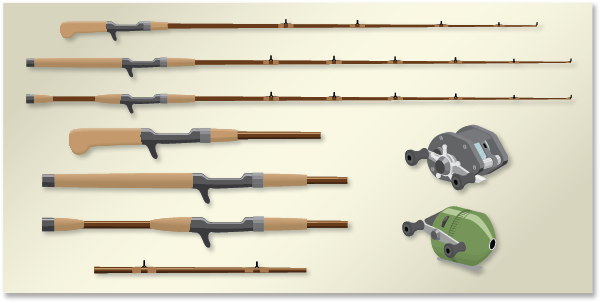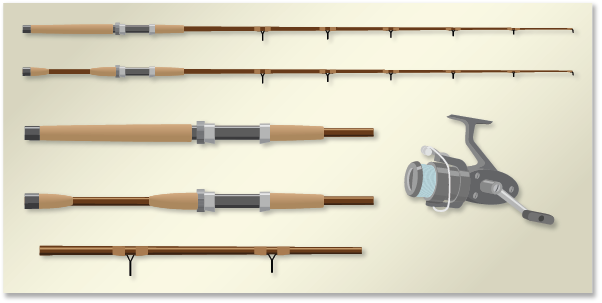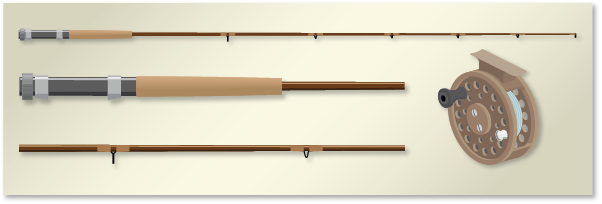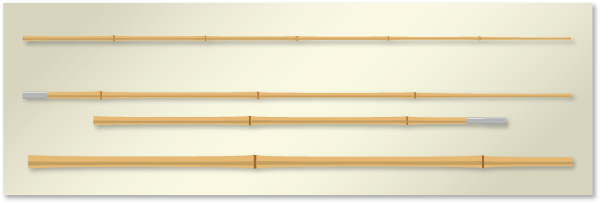Rods
One of the most important pieces of fishing gear is the fishing rod. The rod allows anglers to propel baits and lures to where the fish are and successfully tire and bring the fish in. There’s a rod for every type of fish and fishing style. Most any rod will work for catching fish but using the right rod for the fish being sought can make a big difference in being successful.
The number of rods available can be daunting, so take time to look at what’s available for your type of fishing. Selecting the right rod will help in casting and retrieving the bait or lures used. For example, it would be very difficult to cast a 1/32 ounce jig or fly using a heavy baitcasting rod. For the light jig or fly, either a fly rod or an ultralight spinning rod is needed.
Also consider the material used for the rod. Most fishing rods today are made of fiberglass, graphite, or composite. For strength and durability, a fiberglass rod is a good choice, especially for anglers just starting out. Graphite rods offer strength and durability as well as sensitivity, which makes it a good rod for feeling the bait or lures. Composite rods offer great sensitivity and are very light weight but lack the durability found in fiberglass and graphite rods.
Below are the most common rods used along with their descriptions, dimensions and use.
 Baitcasting Rods
Baitcasting Rods
The baitcasting rod, (three are illustrated) is used with baitcasting or push button reels, and comes in different lengths, actions, style, and materials. The style of rod chosen will depend on the type of fish you’re after and lures or baits used. Using a baitcasting rod differs from other rods such as a spinning rod. Combined with a baitcasting or push button reel, the rod allows you to make long and accurate casts. With the type of grips available, the rod is easily held with four fingers, allowing the thumb to be used for reel control. A casting rod also provides good leverage when fighting fish.
The length of the casting rod usually ranges from 5 to 7 1/2 feet in 6 inch increments, are made from fiberglass and graphite, and with actions varying from light to heavy. Graphite rods are more sensitive than fiberglass, which can be important when fishing plastic worms, lizards or jigs.
Handles come in three styles, pistol grip, split-grip or straight and are made from foam or cork. It’s a personal preference which style of handle to choose. Straight and split-grip handle rods though will allow for two handed casting and might provide better leverage when fighting fish.
Baitcasting Rod Examples
 Spinning Rods
Spinning Rods
The spinning rod is used with a spinning reel, also known as an open face reel. The style of spinning rod chosen will depend on the type of fish you’re after and lures or baits used. Using a spinning rod differs from other rods such as a baitcasting rod. Unlike a baitcasting rod, the reel on a spinning rod hangs down. The rod is held with the last three fingers and thumb, the fore finger is used for controlling the line coming off the reel.
On a spinning rod, not only does the reel hang down, but the guides do too, and are larger than other type rods. This is to accommodate the line, which spirals off the reel in large loops when cast. The large guides also help when reeling in line. Too small of a guide would create too much stress coming across the spool. Combined with a spinning reel, the spinning rod allows you to make long and accurate casts with lighter lures or baits. Over the years, spinning outfits have gotten larger and heavier, allowing the use of heavy lures or weights.
The length of the spinning rod usually ranges from 5 to 7 1/2 feet in 6 inch increments, are made from fiberglass and graphite, and with actions varying from light to heavy. Graphite rods are more sensitive than fiberglass, which can be important when fishing bottom baits like plastic worms, lizards or jigs. Handles come in two styles, straight and split-grip, and are made from foam or cork. It’s a personal preference which handle material to choose.
A spinning outfit is a good choice for beginning fishermen since almost any range of baits or lures can be used, and because the line comes off the reel easier that other reels, the spinning rod is great for ultralight outfits. Small 1/16 ounce jigs can be easily cast with an ultralight spinning outfit.
Spinning Rod Examples
 Fly Rods
Fly Rods
The fly rod, a long slender rod, is used to cast flies or other light baits that can’t be cast using other outfits. Using a fly rod differs from all other rod and reel outfits. Since the weight of the lure isn’t there, a weighted line is used to cast the feather light lures. Instead of using conventional methods to cast, the line is whipped back and forth with the motion of the rod, then laid out straight to the area where the fly or lure is being presented. It is truly an art form and can take time to master. The fly reel, which hangs down from the rod, is at the very back of the rod. This allows the line to be stripped off and held with the hand holding the rod and keeps the reel out of the way when whipping the line. The guides on the rod are small since the line comes off and goes back on the reel in a straight line. Fly rods come in different lengths, weights, actions, and materials.
The length of the fly rod usually ranges from 7 to 9 feet in 1 inch increments, with weights varying from 4 to 12. The higher the weight number, the heavier the action, weight of lure and line, and fish the rod can handle. Handles usually come in one style, straight, and are made from foam or cork. It’s a personal preference which handle material to choose. The materials used in making fly rods are fiberglass, graphite, boron, and split bamboo, the bamboo being the most expensive. Some older rods were also made from steel.
 Bamboo Rods
Bamboo Rods
One of the earliest rods used by almost every angler, especially when younger, is the bamboo rod. Getting its name from the plant from which the rod comes from, the bamboo rod is long and has very little action if any. As in other rods, length and action is a personal preference. As silly as it sounds though, fishing with a bamboo rod has its advantages.
Though it wouldn’t be suitable to attach a baitcasting or spinning reel to a bamboo rod, there are situations where a simple rod like this comes in handy. It’s a good rod to start young anglers out with. No line tangles, snags are easily retrieved, and the price is right. Sometimes even free where businesses get them with rolls of material such as carpet.
Store bought bamboo rods usually come in two pieces, this helps with storage. Line is tied to the end, length is your choice, or small plastic reels can be purchased to store the line. A hook, weight, and float are tied on and you’re ready to go fishing. Though areas to fish are limited to the length of the rod and line, bluegill are easily caught with a bamboo rod outfit. But don’t limit yourself to bluegill, some bass anglers use bamboo rods for flipping jigs. If you don’t do a lot of flipping but need a long rod to drop a jig into some close cover from time to time, a bamboo rod can do the trick. The possibilities are endless. So don’t overlook or throw away that bamboo rod just yet. Pass it on to a young angler or find your own ways to use it.
